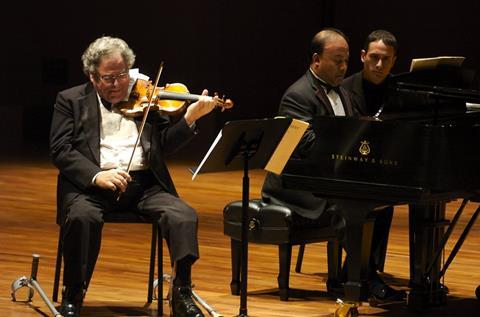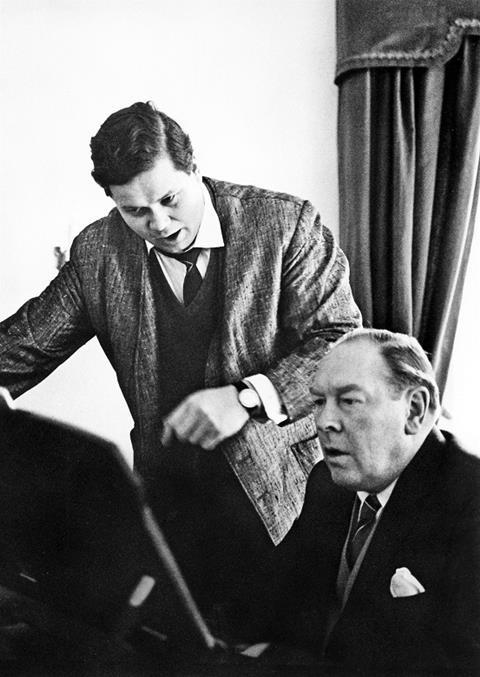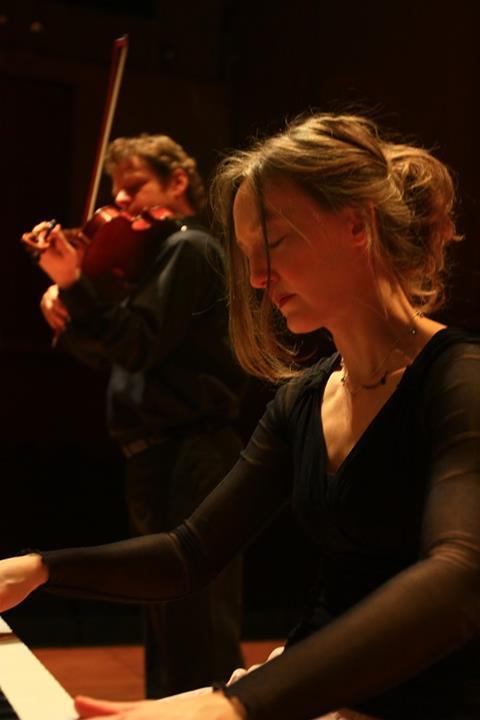String players and pianists are uniting to end the perception of piano accompanists as lesser musicians. Elana Estrin delves into the field of collaborative piano

Discover more Featured Stories like this in The Strad Playing Hub
This article is from the March 2010 issue of The Strad
There has long been a stereotype in the performance community that accompanists are inferior musicians. Not good enough for solo careers, they are hired to perform a service: to obey their musical partner’s instructions without question. But some of the world’s leading classical musicians, including Itzhak Perlman (pictured), take offence at this misconception. ‘It’s true: there’s no such thing as an accompanist,’ says Perlman. ‘A lot of the repertoire, like Beethoven and Mozart sonatas, is written for piano and violin. The pianist is so important. The word “accompanist” is a total mistake.’
Attitudes have begun to change in recent years, thanks to the pianists and other instrumentalists who have rallied together to eliminate the hierarchy implied by the term that has, well, accompanied pianists for so long. The result has brought about a new title – collaborative pianist – and a paradigm shift in the classical music world, which views pianists as equal partners rather than as subordinates.
Historic collaborations
An early champion for piano accompanists’ rights was English pianist Gerald Moore, who collaborated with such instrumentalists as Pablo Casals and Yehudi Menuhin. Moore’s book The Unashamed Accompanist was published in 1943. In the opening chapter, Moore admits that he used to think ‘the accompanist was a sort of caddie who carried the violinist’s fiddle… but after some years of work and experience I began to realise how important and interesting the musical life of an accompanist could and should be.’

‘Think way back to the early 1900s,’ says professor of collaborative piano at the Cleveland Institute Virginia Weckstrom. ‘Pianists were hired into studios to make recordings with artists, and they didn’t even put the name of the pianist on the label. Gerald Moore came along and insisted that he wouldn’t record anything unless he had his name on the label. He was such a fabulous pianist that they complied. This opened a whole new door.’
Following Moore’s initial efforts, pianist Samuel Sanders, who collaborated with the likes of Yo-Yo Ma, Itzhak Perlman and Mstislav Rostropovich, continued the fight for more equal footing. One of his lasting contributions to the field was coining the term ‘collaborative pianist’. Sanders didn’t stop at changing the accepted terminology. Following the establishment of the first collaborative piano degree programme at the University of Southern California in 1947, he pushed to establish a masters degree in collaborative piano at the Juilliard School when he joined its faculty in 1963. Since then, close to a hundred collaborative piano degree programmes have been established in conservatoires throughout the world.
In addition to aiding the performance community to see collaborative piano as a viable professional option, Moore and Sanders also paved the way for leading solo pianists to consider collaborating. This, in turn, engendered even more respect for the field. ‘When famous solo pianists – Emanuel Ax, Daniel Barenboim, Joseph Kalichstein – began publicly, visibly and enthusiastically collaborating and presenting themselves as partners, it really helped to elevate the awareness that this is not a lesser art,’ says Anne Epperson, who served as Jascha Heifetz’s staff pianist at the University of Southern California, and is currently professor of collaborative piano at the University of Texas.
‘Once, they billed me as Mr Perlman’s accompanist. I said: “No, no, no, no, no! Either pianist or collaborative artist.” You’ve got to make them learn’ – ROHAN DE SILVA
Moving into the mainstream
Thanks to Moore, Sanders, and other rallying musicians, the field of collaborative piano has grown in the last few decades. But as Itzhak Perlman's long-time collaborative pianist Rohan De Silva is quick to point out, there is still a long way to go. ‘I wish Sanders were alive to see that it’s recognised,’ he says. ‘But I think still more could be done. We’ve got to get the younger generation to understand how important it is.’
Anne Epperson has been particularly instrumental in creating opportunities for music students to study alongside collaborative piano peers. She requires her collaborative piano students to bring their partners to all their lessons. ‘I also expect the same thing to be happening to my students when they go to their partners’ lessons,’ she says. ‘I want them to learn to listen from the standpoint of a string player. For me, it’s crucial that the whole process is collaborative and benefits everyone involved. It’s not just about the pianists. It has to be about the team.’

It’s also about the team for Itzhak Perlman, who has this advice on finding a compatible partner: ‘Look for somebody who is pleasant to work with. You don’t want to work with an ornery person. You basically have to travel together. Obviously the quality of their playing is paramount. But besides that, it’s a social thing as well.’
Epperson also emphasises the mutual respect both collaborative partners should have for one another. ‘Don’t wait until the last minute to give the pianist the music,’ she advises. ‘Planning ahead and allowing your collaborative partner the same kind of preparation that you have will result in a mutually professional performance. And don’t just throw your pianist into one rehearsal. It makes it very challenging for the instrumentalist to then incorporate the piano part into the performance, and it won’t be integrated.’
In addition to instilling respect in students for their collaborative partners, teachers say that it is imperative to help them understand what their responsibilities are at every stage of the collaboration, from before the first rehearsal to the last bar of the final performance. ‘The most important thing is to come into the relationship having learnt both parts before the first rehearsal,’ Epperson advises. ‘In the preparation stage, the responsibilities are again mutual and equal: both should be proactive and respectful in sharing the knowledge of their individual craft. And then when the moment of truth arrives, the responsibilities change slightly. Ultimately, the pianist has to be flexible and aware, and hopefully their partner will not cease to communicate. It’s the pianist’s responsibility always to be attentive and ready to adjust if necessary.’
5 RULES FOR COLLABORATING WITH A PIANIST
Treat your pianist as an equal. The piano part is often at least as difficult as the string part, and several composers – Mozart and Beethoven in some of their violin sonatas, for example – regarded the piano voice as more important.
Give the music to your pianist well ahead of time so that you will both be fully prepared by the time of the first rehearsal. Schedule enough rehearsal time to integrate the two parts and build a convincing interpretation.
Know the score. The pianist has an advantage in being able to work from a score, so if you don’t know how the two parts fit together, you may potentially waste a lot of rehearsal time.
Work together to create a mutually satisfying interpretation. This is likely to require more discussion than the old-fashioned lead-and-follow approach, but the rewards in terms of developing an intuitive understanding of each other’s playing will be well worth it.
Acknowledge the pianist’s equal status in the performance. Ensure that the concert hall includes the pianist’s name and biography in the programme. Bow together, side by side at the front of the stage. Remember, the literature for stringed instrument and piano is chamber music, so a pianist in a partnership should receive as much respect as a pianist in a piano trio.
What string players should do differently
Collaborative pianists and instrumentalists agree that the number one mistake string players make when playing with a collaborative pianist is not to study the full score. ‘Many don’t know the score well enough to realise how important the piano is,’ says Ronald Leonard, professor of cello and chamber music at the Colburn Conservatory of Music. ‘If you approach it in such a way that you think you only need to know the cello or violin part, you’re always likely to think the piano is a secondary member of the collaboration. That makes for a very poor performance. You have to respect what the pianist brings to the music.’
Another frequently cited problem is that students underestimate the importance of listening to the piano. ‘A musical collaboration is like a conversation. I say something, then you say something,’ pianist Akira Eguchi says. ‘Often string players say lots of nice things but just by themselves. They don’t have ears to listen to what the other musician is saying. If they pay a tiny bit of attention to the pianists, they will soon realise that making music becomes so much easier.’ Paul Kantor, professor of violin at the Cleveland Institute, suggests that the two players switching roles can be useful to teach this principle of communication: ‘I have the pianist play like it was a solo piano sonata, and I will ask the violinist to follow the pianist.
Read: ‘Keeping the accompanist on his toes’ - Postcard from Santander
Read: ‘Don’t write it down. Remember it!’ - Inside Jascha Heifetz’s teaching studio
Discover more Featured Stories like this in The Strad Playing Hub
Then I will ask the pianist to play it three or four different ways, with different rubatos. And without verbalising what they’re going to do, I ask the violinist to follow whatever the pianist has presented. It’s sort of a turning of the tables.’ To facilitate communication further, Lewis suggests adding a breath of fresh air – literally. ‘Often, I see that the string player forgets to breathe. Breathing is a natural way to connect with your sonata partner. It can communicate so much. It’s a form of letting your partner know when you’re starting, and it also helps establish bow stroke.’ Epperson notes that even when the pianist is playing a concerto reduction or showpiece rather than a sonata with violin or cello (considered to be the traditional collaborative repertoire), the principles of collaboration should still hold: ‘It should be a relationship of two equal partners, no matter what the music is, whether it’s the most diffi cult sonata or a piece with a true accompaniment.’
‘The best performances are truly collaborative in nature, where both people contribute and have a real dialogue about the music’ – PAMELA VIKTORIA PYLE
Keep an open mind
Inevitably, differences of opinion arise in any collaboration that could threaten the ideal equal-partnership dynamic. Pyle shares an example of such a confl ict with a collaborative partner. ‘I knew he couldn’t handle me having any expressive ideas. In the end, he had an idea about pedalling. He fi nally said, “I like it this way.” That was the end. I thought: “Wow, that’s the last refuge of the truly desperate: I’m not even trying to convince you. I win.”’For situations such as these, Pyle suggests that musicians always keep the ultimate objective in mind: ‘Ideally, the goal is to present the music as well as it should be presented. If both people have that at heart, then I think they’ll work through any artistic differences. But if they are thinking: “I need to be right, I need to have my interpretation on stage,” it’s going to be a lot harder.
Ultimately, it won’t serve anyone. But that’s the hardest part: finding diplomatic ways to speak to someone so that you’ll be heard. I think it’s perceived more as the pianist’s job to be the arbiter, but I think both partners should be.’ In order to achieve this goal of presenting the best musical product possible, Weckstrom encourages collaborative partners to keep an open mind. ‘There are many ways to approach any given musical phrase and be very convincing,’ she says. ‘Try to see how the other person feels it. You may have to negotiate. Go to that fi rst rehearsal well-prepared with ideas, but also go with an open mind to embrace other ideas as well.’ By welcoming each other’s ideas, both musicians remain actively involved in the creative process. To this end, Perlman encourages collaborative partnerships in which both partners lead each other. ‘It’s nice to have someone who’s really working with you, not someone who’s going to follow you doing oompah, oompah. It’s another artist, basically,’ he says.

Still much to learn
According to Epperson, ‘collaborative pedagogy is still in its infancy’. But she suggests that collaborative etiquette and skills can be taught when instrumentalists themselves are in their musical infancy. ‘In terms of training young string players and pianists to respect each other and work together constructively, you can actually start a lot earlier than one might think,’ Epperson says. Sitting in her studio at the University of Texas’s Butler School of Music, she reaches for a volume on her shelf: Accompanying the Violin by Katherine D. Johnson. Containing pieces for young violinists and pianists to play together, the book teaches the next generation of pianists good collaborative habits from the beginning.
‘When friends accompany each other on a walk, no one can tell who is walking with whom,’ Johnson writes. ‘Thunder accompanies lightning, but neither one overshadows the other. This is also true when a pianist accompanies a violinist: neither part is more important than the other. Both parts together make up the whole piece – that’s how the composer intended it.’
Read: Five rules for collaborating with a pianist
Read: My father Slava - by Elena Rostropovich
Discover more Featured Stories like this in The Strad Playing Hub
This article is from the March 2010 issue of The Strad
Best of 2023: The Strad Playing Hub
- 1
- 2
- 3
- 4
- 5
- 6
- 7
- 8
 Currently reading
Currently readingThere is no such thing as a piano 'accompanist'
- 9
- 10
- 11





















































1 Readers' comment